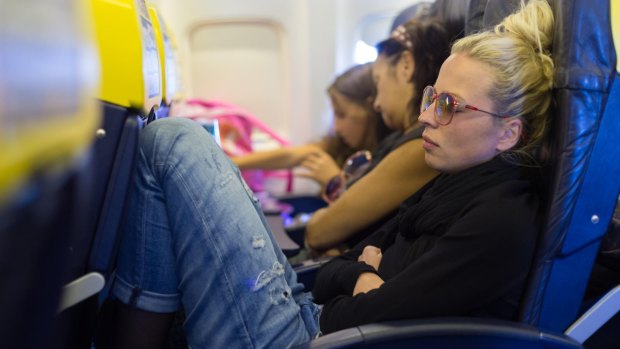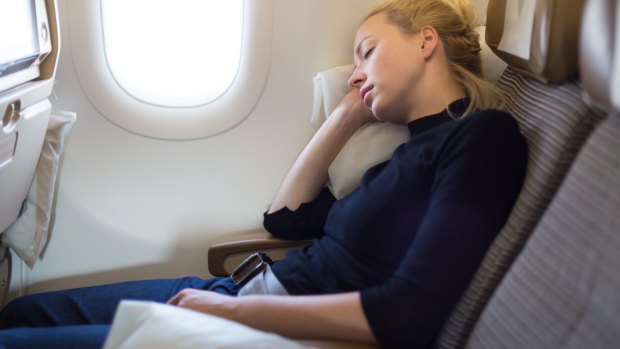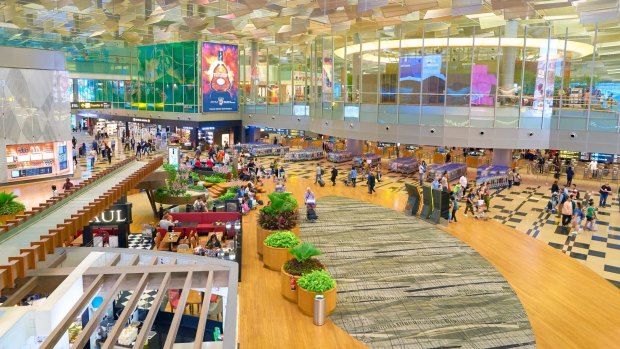This was published 4 years ago
Tips for how to sleep on planes: The best aircraft type, seat, what to eat and more
By Michael Gebicki

Choose your plane and seat carefully if you want the best chance of getting some sleep on your flight.Credit: Alamy
Now that 14-hour flight times are common on at least one sector on a flight to Europe, and some non-stop flights are heading toward 20 hours, you need to plan ahead if you're expecting to catch some sleep on board. Where to sit, which aircraft type, eating vs abstinence, pills, achieving silence or at least calm, which fluids and how much all matter. Put some prep work into your inflight experience and you'll cop some meaningful rest and arrive in better shape.
Aircraft Type
Aircraft type is about the least important factor for most flyers but if comfort is a priority, it matters. The preference for many long-haul flyers is the Airbus A380. Spacious, quiet and stately as a dowager, there's heaps to like about the twin-aisle giant. If there's an economy section on the upper deck, it's smaller and quieter so go for it if your fare type or loyalty status allows you to select a seat there. If not, arrive early at the check-in desk and ask.

Window seats are preferred, with the added advantage that you can sack out against the window without having to apologise.Credit: Shutterstock
New generation aircraft such as the Boeing 787 Dreamliner and the Airbus A350 XWB are constructed extensively from Carbon Fibre Reinforced Polymer and this allows higher cabin pressure. That means more oxygen, more moisture and – all else being equal – a more comfortable flight. They're also quieter – but all this can be undone by unruly passengers. The modest comforts afforded by a 787 Dreamliner were not enough to offset the horrors endured on my recent Air India flight from Delhi to Sydney.
Diligent flyers will consult SeatGuru to check the seat configuration of their aircraft. As well as seat pitch, seat width tells you how comfortable your flight is likely to be. A seat width of 43.2cm is a squish, an extra 2.5cm makes a difference.
In economy, an A380 should seat 10 per row on the lower deck, look for nine seats per row on a Boeing 777, 787 or A350 and on an Airbus A330/340, eight across.
Where to sit
Sit where you won't be disturbed. Window seats are preferred, with the added advantage that you can sack out against the window without having to apologise. Since it's more difficult to move from these seats they carry a higher risk of deep vein thrombosis so make sure you get out and hike around the cabin at every opportunity to get your circulation system pumping.
Avoid seats that are close to toilets and galleys, both high-traffic zones. The empty space behind bulkheads can become a gathering zone for passengers waiting to use the loo and a play zone for toddlers so avoid the exit row seats located behind the bulkhead. The bulkhead is also where bassinets are located, another reason to keep your distance.
The Comfort Team
Neck cushions, either foam or inflatable, ear plugs and eye masks all help shut out noise and light and get some undisturbed sleep. Getting your temperature right is important. That's hard to control but a T-shirt plus another layer on top means you can customise. Cabins are more likely to be cold that hot so take a jumper or a lightweight shawl.
Don't forget to buckle the seat belt over the top of your blanket, unless they can see it crew might wake you if the "Fasten Seat Belts" sign goes on. Many flyers fail to realise that most aircraft headrests are adjustable. They go up and wings fold at the sides to stop your head from flopping around.
Pills
Some swear by them, for others they don't work at all. Melatonin, Phenergan or herbal medications might help you sleep but for prescription-only sedatives, follow your doctor's advice. Many of these oral sleep aids should not be taken with alcohol.
Food and beverages
All the experts advise eating lightly. Big meals make it harder to sleep as your heart works harder to pump blood to your stomach and intestines. There is now some evidence to support the theory that starvation might be good for jetlag since the time when we eat plays a role in setting our body clock. According to the Argonne Anti Jet Lag Diet which has developed from this theory, on flight day travellers eat lightly but then eat a big breakfast to coincide with early morning in the destination time zone.
Alcohol is either best avoided or limited. A glass of wine or three might help get you to dreamland more quickly than mineral water but your sleep probably won't be as sound. Your body is more prone to dehydration when you drink alcohol and dry cabin air exacerbates that effect. If you wake with a headache, sleep just went out the window.
The stopover

Credit: SHUTTERSTOCK
On a flight to Europe the stopover will be somewhere in East or North Asia or else Dubai, Abu Dhabi or Doha. Rather than wandering around inspecting overpriced duty-free goods, spending the time in a pay-for-use lounge is a more relaxing alternative. Pay-for-use lounges are now a fact at airports, and most big international hubs will have several.
The best offer showers, a decent buffet, ample seating with quiet nap zones away from TVs, charge facilities for phones and other devices and high-speed Wi-Fi. They're not cheap, and while some are worth it, most aren't.
In a really super airport like Singapore's Changi, with vast open spaces, relaxation areas, gardens, lots of food and beverage outlets, free movies and free showers, the value of a pay-for-use lounge is questionable. However, there are no other airports like Changi. Most are crowded, jostly and not much fun to hang out in. If you're stuck in one of those for a couple of hours or more, a calm lounge is going to make a difference to how you feel at the other end, but check reviews on TripAdvisor, standards and amenities vary wildly.
See also: Airport review: There's a reason why Changi is the world's best
Another option is exercise, and quite a few airports now have fitness centres with gyms and pools. There's lots to be said for a brisk workout, and plenty of therapists who will tell you a stretch, load-bearing exercise and something that gets your heart pumping is a great way to recover when you've been squashed in an aircraft seat for 14 hours – or as preparation for that same flight. Some of these fitness centres also offer massages, and that's not hard to take either.
See also: Hour by hour: My epic trip on board the world's longest flight
See also: Qantas' 17-hour Perth to London non-stop flight: Economy passengers' verdict
Sign up for the Traveller newsletter
The latest travel news, tips and inspiration delivered to your inbox. Sign up now.